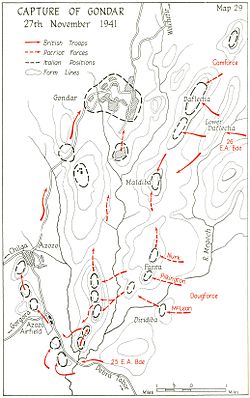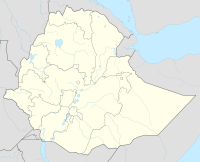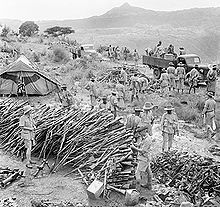
Gideon Force was a small British and African special force, a Corps d’Élite with the Sudan Defence Force, Ethiopian regular forces and Arbegnoch. Gideon Force fought the Italian occupation in Ethiopia, during the East African Campaign of the Second World War. The leader and creator of the force was Major Orde Wingate. At its peak, Gideon Force had fifty officers, twenty British NCOs, 800 trained Sudanese troops and 800 part-trained Ethiopian regulars, a few mortars but no artillery and no air support, except for intermittent bombing sorties.
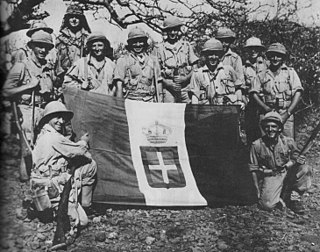
The East African campaign was fought in East Africa during the Second World War by Allies of World War II, mainly from the British Empire, against Italy and its colony of Italian East Africa, between June 1940 and November 1941. The British Middle East Command with troops from the United Kingdom, South Africa, British India, Uganda Protectorate, Kenya, Somaliland, West Africa, Northern and Southern Rhodesia, Sudan and Nyasaland participated in the campaign. These were joined by the Allied Force Publique of Belgian Congo, Imperial Ethiopian Arbegnoch and a small unit of Free French Forces.

Imba Alaje is a mountain, or an amba, in northern Ethiopia. Located in the Debubawi Zone of the Tigray Region, Imba Alaje dominates the roadway that runs past it from the city of Mek'ele south to Maychew. Because of its strategic location, Emba Alaje has been the site of several battles. As Anthony Mockler describes it,
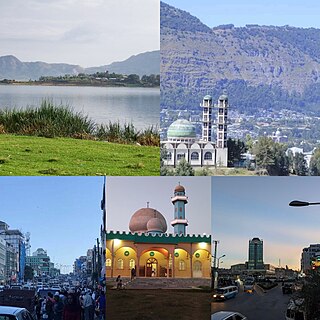
Dessie is a town in north-central Ethiopia. Located in the South Wollo Zone of the Amhara Region, it sits at a latitude and longitude of 11°8′N39°38′E, with an elevation between 2,470 and 2,550 metres above sea level. Dessie is 400 km to the north of the capital Addis Ababa. It has a population of more than 200,000 people in over 30 wards.

Debre Tabor is a town and woreda in northern Ethiopia. Located in the Debub Gondar Zone of the Amhara Region, about 100 kilometers southeast of Gondar and 50 kilometers east of Lake Tana, this historic town has a latitude and longitude of 11°51′N38°1′E with an elevation of 2,706 metres (8,878 ft) above sea level. The presence of at least 48 springs in the area contributed to the development of Debre Tabor.

Prince Amedeo, 3rd Duke of Aosta was the third Duke of Aosta and a first cousin once removed of the King of Italy, Victor Emmanuel III. During World War II, he was the Italian Viceroy of Italian East Africa.

Guglielmo Ciro Nasi was an Italian general who fought in Italian East Africa during World War II.

The Italian invasion of British Somaliland was part of the East African campaign (1940–1941) in which Italian, Eritrean and Somali forces of Fascist Italy entered the Somaliland Protectorate and defeated its garrison of British, Commonwealth and colonial forces supported by Somali irregulars. The Italian victory was based on mobility and speed but was hampered by the terrain, rainy weather and British resistance.

The Royal Corps Of Eritrean Colonial Troops were indigenous soldiers from Eritrea, who were enrolled as askaris in the Royal Corps of Colonial Troops of the Royal Italian Army during the period 1889–1941.

The 40th Infantry Division "Cacciatori d’Africa" was an infantry division of the Royal Italian Army during World War II. The Cacciatori d’Africa was formed on 27 July 1940 from troops and reservists stationed in Italian East Africa. The Cacciatori d’Africa, together with the 65th Infantry Division "Granatieri di Savoia" were outside the regular Royal Italian Army chain of command, and subordinated directly to Prince Amedeo, Duke of Aosta, the Viceroy of Italian East Africa. The division dissolved on 15 May 1941 after being decimated during the East African campaign.

The 65th Infantry Division "Granatieri di Savoia" was an infantry division of the Royal Italian Army during World War II. The Granatieri di Savoia was formed on 12 October 1936 in Littoria and disbanded on 20 April 1941 in Soddu, Ethiopia. The division's name translates as "Grenadiers of Savoy", with the House of Savoy being the ruling family of the Kingdom of Italy.
Dabat is a town in northern Ethiopia, located about 50 kilometers north of Gondar in the Semien Mountains along the Gondar-Debarq highway Dabat it is in the Semien Gondar Zone of the Amhara Region, and is one of two towns in Dabat woreda.

Amhara Governorate was one of the six governorates of Italian East Africa. Its capital was Gondar. It was formed in 1936 from parts of the conquered Ethiopian Empire following the Second Italo-Ethiopian War. It had a population of more than 2 million inhabitants. In November 1938 some territory of Amhara in the Scioa region was given to the neighboring Addis Abeba Governorate, enlarging it to the Scioa Governorate.

The Battle of Amba Alagi was fought in May 1941, during World War II, part of the East African Campaign. After the Italian defeat at Keren in April 1941, Prince Amedeo, Duke of Aosta withdrew his forces to the mountain stronghold at Amba Alagi. The mountain had galleries carved into the rock to protect the defending troops and hold ample ammunition and stores and the Italian troops thought themselves to be impregnable. According to other sources, however, the fortress was easily defendable thanks to its position and the mountainous terrain, but lacked food and water, so that Marshal Enrico Caviglia later criticised the Duke for having chosen it for his last stand, calling the Amba Alagi "uno scoglio senz'acqua e senza viveri". The initial attacks on the approaches to Amba Alagi by British troops under Major-General Mayne from the north, commenced on 4 May with a pincer from the eastern and western sides.

Uolchefit is a place in Amhara Region, Ethiopia. Its time zone is Africa/Addis_Ababa (UTC). It is also written Wolchefit, Wolkefit or Wilkifit.
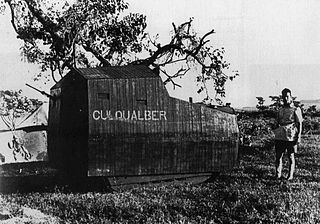
The Battle of Culqualber was fought near Culqualber Pass, Ethiopia, from 6 August to 21 November 1941, between Italian and colonial forces and British Commonwealth forces. Along with the Battle of Gondar, it marked the end of conventional warfare in the East Africa Campaign.
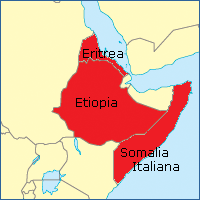
Operations on the Northern front, East Africa, 1940 in the Second World War, were conducted by the British in Sudan and the Armed Forces Command of Italian East Africa in Eritrea and Ethiopia. On 1 June 1940, Amedeo, Duke of Aosta the Viceroy and Governor-General of the Africa Orientale Italiana, commander in chief of the Armed Forces Command of the Royal Italian Army and General of the Air Force, had about 290,476 local and metropolitan troops and by 1 August, mobilisation had increased the number to 371,053 troops. General Archibald Wavell, General Officer Commanding-in-Chief (GOC-in-C) of Middle East Command, had about 86,000 troops at his disposal for Libya, Iraq, Syria, Iran and East Africa. About 36,000 troops were in Egypt and 27,500 men were training in Palestine.

The Battle of Agordat was fought near Agordat in Eritrea from 26 to 31 January 1941, by the Italian army and Royal Corps of Colonial Troops against British, Commonwealth and Indian forces, during the East African Campaign of the Second World War. The British had the advantage of breaking Italian codes and cyphers before the offensive and received copious amounts of information from Italian sources on the order of battle and plans of the Regia Aeronautica and the Italian army.

The siege of Saïo or battle of Saïo took place during the East African Campaign of World War II. Belgo-Congolese troops, British Commonwealth forces and local resistance fighters besieged the fort at the market town of Saïo in south-western Ethiopia in 1941. The siege lasted for several months, culminating in an Allied attack on the Italian garrison thereby forcing it to surrender.

On May 12, 1936, Emperor Haile Selassie of Ethiopia delivered a speech condemning Italian military aggression against Ethiopia, which had forced him into exile. The speech took place in League of Nations assembly in Geneva. The speech also denounced the Italian army's use of chemical weapons against the Ethiopian population.
